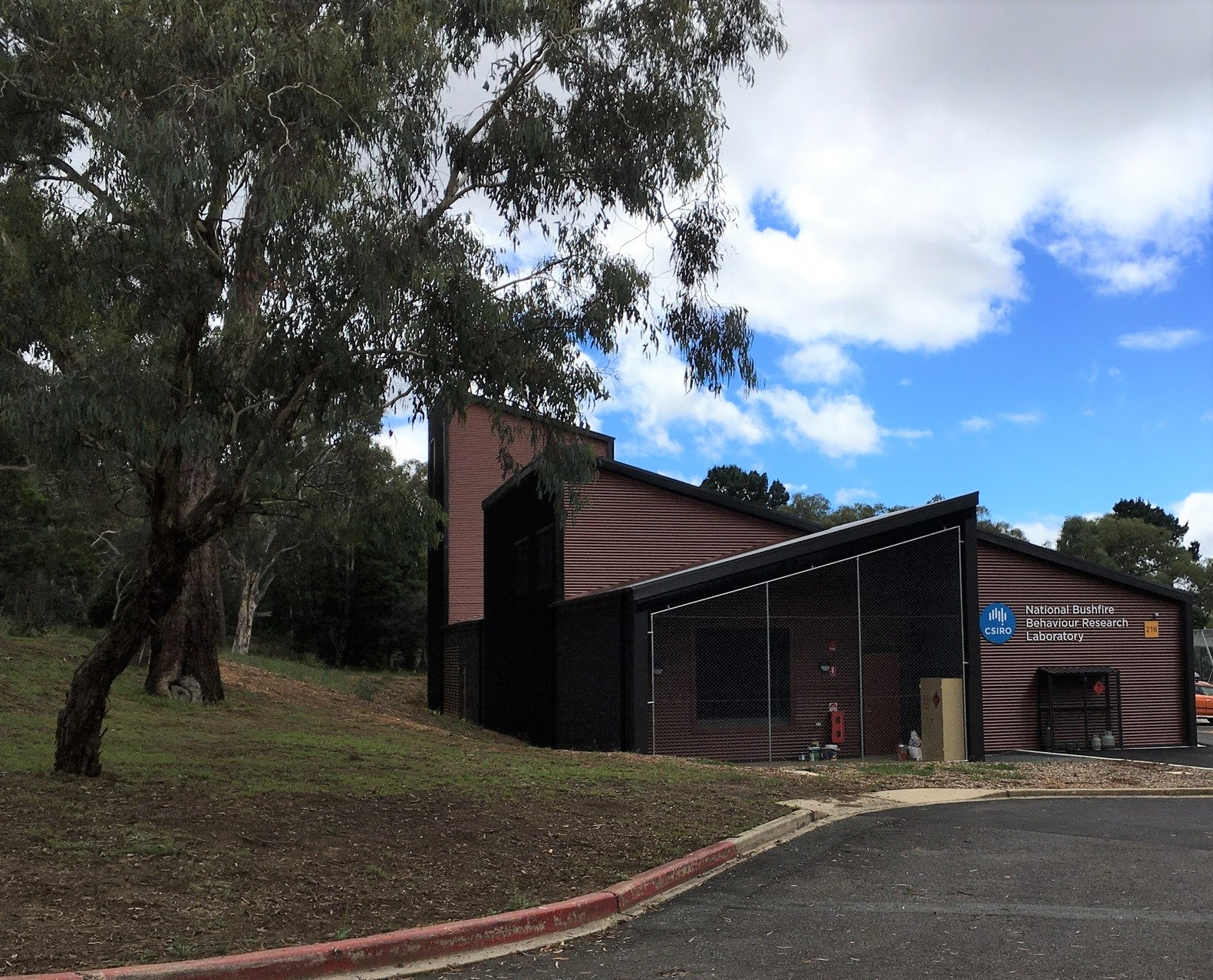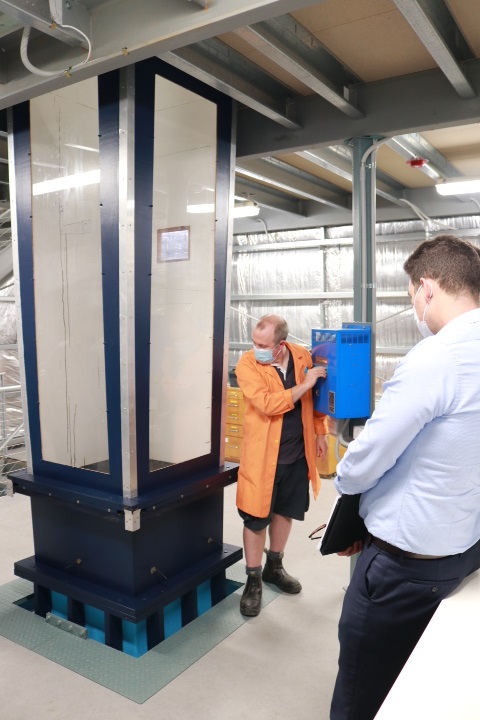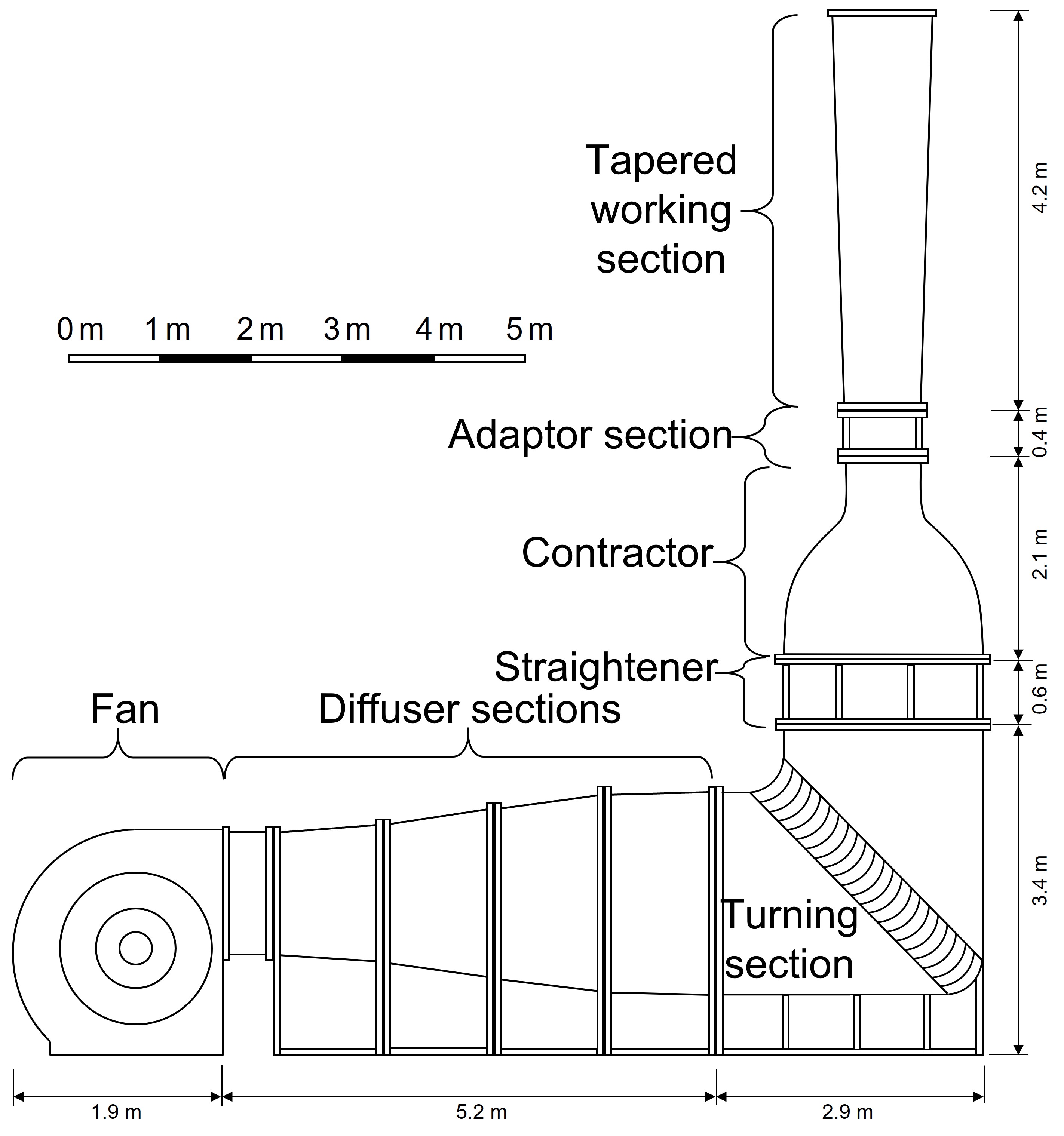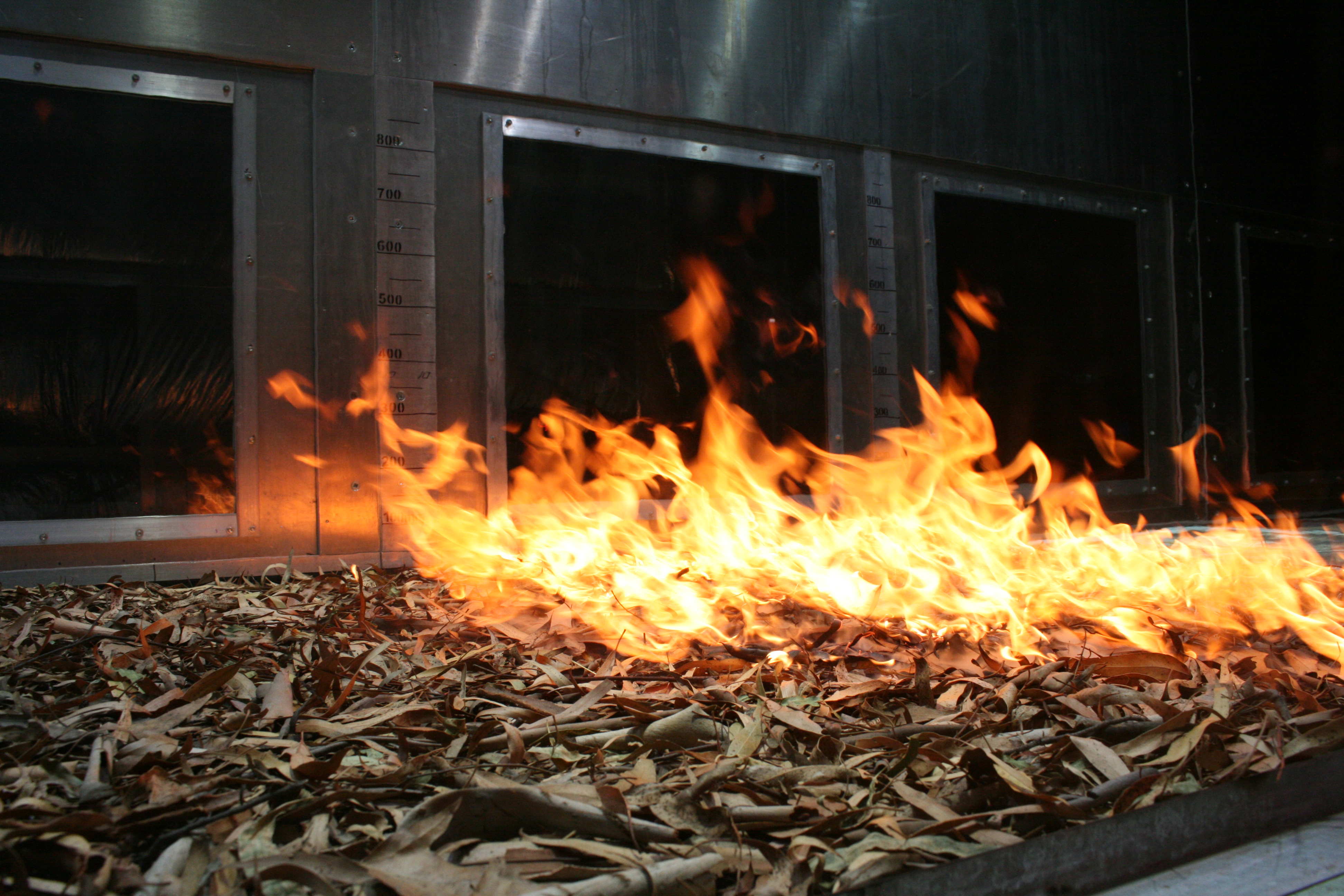Our unique laboratory is dedicated to the study and testing of fundamental bushfire dynamics. The objective is to derive accurate results that support the management of bushfires.

The laboratory houses the CSIRO Bushfire Behaviour and Risks research team and is home to the CSIRO Pyrotron and the CSIRO Vertical Wind Tunnel (VWT).
The Pyrotron is a combustion wind tunnel designed to enable the safe and repeatable investigation of the mechanisms of flame propagation in bushfire fuels such as grass, forest litter and shrubs, under a range of burning conditions. This includes conditions such as those of an extreme fire danger day. Factors such as wind speed, fuel type and structure, fuel load and fuel moisture content can be precisely varied or strictly controlled.
The VWT is designed to study the combustion and aerodynamic characteristics of burning bark and other firebrands at their terminal velocity. Firebrands ignited in a bushfire are lofted in the fire’s plume and carried ahead by the wind where they fall to the ground and start spotfires. Such firebrands and subsequent spotfires are the main cause of bushfires escaping containment as well as house loss and damage.
The Pyrotron and VWT allows us to:
- gain a better understanding of the physical processes involved in the behaviour and spread of bushfires under a range of conditions
- utilise a range of scientific instrumentation to quantify specific physical attributes of the behaviour and spread of fires and firebrands, including IR thermography, turbulence, and thermal characteristics
- explore the effects of a broad range of weather and fuel conditions on flame propagation, including those associated with extreme wildfires
- develop better models of the influence of key parameters such as fuel moisture, wind speed and ignition configuration on fire behaviour to improve effectiveness and safety of firefighting
- improve the design and execution of large-scale field experiments, particularly of specific instrumentation used for such experiments
- develop a better understanding of likely emissions from bushfires in different fuel and burning conditions
- develop better models of the fire spotting process through improved understanding of the aerodynamics and combustion characteristics of firebrands.
The Pyrotron and VWT facility were previously located at CSIRO’s Yarralumla site until they were moved in 2021 to the larger purpose-built laboratory at CSIRO Black Mountain. The VWT was first opened by CSIRO CEO Dr Malcolm McIntosh in 1997. The Pyrotron was first opened by Hon. Senator Kim Carr in 2008.
The bushfire lab is a CSIRO-owned national facility. It is available for use by arrangement by any external organisations to better understand fire behaviour and their impacts.
About the Pyrotron
This national research apparatus builds on over 60 years of experience CSIRO has with conducting large-scale field experiments for fire behaviour studies. It enhances research on bushfire behaviour by enabling observations of flame propagation and fire behaviour not possible in field experiments due to limited and uncontrollable burning conditions, reduced access, and safety concerns.
The Pyrotron is a 29-m-long combustion wind tunnel with 2 m × 2 m cross-section. It has a 7.2-m-long working section that provides for a 1.5-m-wide fuel bed for any surface fire fuels, such as forest litter, grasses or small shrubs. Fuels can be preconditioned in the large oven to approximate a wide range of fuel moisture contents. The large capacity centrifugal fan can generate air speeds at the fuel level of up to 20 km/h, equivalent to about 60 kilometres an hour in the open.
The Pyrotron allows us to gain a better understanding of the physical processes involved in the propagation of flames in bushfire fuels and their behaviour under a range of burning conditions. We conduct highly structured experiments with strong statistical bases that will assist us to develop better models of the factors that influence fire behaviour. This improves effectiveness and safety of fire-fighting. It also improves the design and operation of instrument packages intended for large-scale field experiments.
Selected publications
Since it was opened in 2008, publication of research conducted at the Pyrotron has helped build the nation's knowledge. A selection of research articles are provided below:
- A contractionless, low-turbulence wind tunnel for the study of free-burning fires (2013)
- Greenhouse gas emissions from laboratory-scale fires in wildland fuels depend on fire spread mode and phase of combustion (2014)
- Repeatability of free-burning fire experiments using heterogeneous natural forest fuel beds in a combustion wind tunnel (2016)
- Comparing the relative effectiveness of suppressant enhancers designed for the direct attack of wildfires (2017)
- Comparison of three methods to quantify the fire spread rate in laboratory experiments (2017)
- Effect of woody debris on the rate of spread of surface fires in forest fuels in a combustion wind tunnel (2018)
- Investigation of mercury emissions from burning of Australian eucalypt forest surface fuels using a combustion wind tunnel and field observations (2019)
- Investigation of the effects of interactions of intersecting oblique fire lines with and without wind in a combustion wind tunnel (2019)
- Two methods for calculating wildland fire rate of forward spread. International Journal of Wildland Fire (2020)
- Initial growth of fires in eucalypt litter, from ignition to steady-state rate of spread: laboratory studies (2022)
Features of the Pyrotron
Tunnel
- 29 m long
- 4 m² in cross section
- Flame-proof aluminium and steel construction.
Wind
- 2 tonne fan capable of moving 22 cubic metres of air a second
- Variable wind speed of up to 5 metres per second, equivalent to ~60 kilometres per hour in the open if considered under a medium-tall eucalypt canopy
- Computer controlled and programmable fan speed
- Low turbulence intensity (<0.6%).

Fuel bed
- 1.5 m wide by 7.2 m long
- Insulated with flame-resistant ceramic tiles
- Ethanol point or line ignition sources with electronic initiation
- Toughened-glass viewing doors for observing the fire
- Artificially illuminated, so that the fuel will be visible against the light from flames
-
Can hold fine surface fuels up to a load of 25-30 tonnes/ha, equivalent to a very long unburnt forest
- Can accommodate different fuel types, such as small logs, shrubs, leaves, forest litter or grasses
- Fuels can be artificially dried to replicate extreme burning conditions associated with wildfires.
Instrumentation and observations
- A wide range of sensors in the working section ensure correct and accurate measurement
- Data is captured by a high-speed multi-channel data acquisition system that provides real-time output of sensors to a multi-display system
- Multiple high definition video cameras above and from the side of the Pyrotron, a high speed camera capable of shooting HD footage at 1000 frames per second, and a high resolution infra-red thermal imaging camera capture details of combustion.
Other details
- Relies upon ambient temperature and humidity, meaning that experiments can be conducted on days of high heat and low humidity to observe fire behaviour in extreme conditions regardless of wind speed or fire danger.
- Experiments last about 15 to 20 minutes, depending on fuel and burning conditions and generally yield about as much smoke as a wood-fired backyard barbecue.
About the Vertical Wind Tunnel (VWT)
The VWT is a 10.7 m-tall apparatus designed to allow the study of untethered burning firebrands falling in an air stream at their terminal velocity.
Firebrands are any bits of bark or other vegetation debris that are ignited in a bushfire, lofted in the fire’s plume, and carried ahead by the wind to start spotfires downwind of the originating fire. Firebrands, embers and the spotfires they start are the main cause of escape of bushfires from containment and the damage and loss of houses in a bushfire. Spotfires also enable a bushfire to cross significant breaks in topography and fuel such as roads and rivers.
For a given set of burning conditions and behaviour of an originating fire, the distance that a viable firebrand (one that can start a spotfire) may be lofted and carried downwind depends on its mass, area and aerodynamics which vary as the firebrand combusts and its terminal velocity (the speed with which it falls through the air) changes. Understanding the change in terminal velocity of a firebrand as it combusts at its terminal velocity is essential to accurately determining the potential distance that a firebrand may travel. The duration which a firebrand remains viable, and the ignition potential of the fuel in which the firebrand lands, are critical to determining the probability that the firebrand will start a spotfire.

Selected publications
- The effect of the aerodynamic behaviour of flakes of jarrah and karri bark on their potential as firebrands (2010)
- Fuelbed ignition potential and bark morphology explain the notoriety of the eucalypt messmate ‘stringybark’ for intense spotting (2013)
- Firebrand characteristics of the stringy bark of messmate (Eucalyptus obliqua) investigated using non-tethered samples (2013)
- The likelihood of ignition of dry-eucalypt forest litter by firebrands (2015)
- Long-distance spotting potential of bark strips of a ribbon gum (Eucalyptus viminalis) (2015)
Features of the VWT
Tunnel
- 10 m long, 10.7 m tall; minimum path length is 18.1 m
- Diverging 4.25 m long working cross-section, from 0.77 × 0.77 m at its base to 1.0 × 1.0 m at the exit
- A 90° turning section consisting of vanes with a radius of curvature of 350 mm and chord length of 500 mm
- Large observation windows allow visual and video recording of firebrand characteristics
- A non-axially-symmetric Borger-profile contractor section is fabricated from laminated 3‑mm high density particle board coated in fibreglass.
Wind

- 1.25 tonne fan capable of moving 11 cubic metres of air per second
- Variable air speeds up to 20 metres per second using variable fan speed controller
- Divergent working section creates velocity gradient at a fixed fan speed
- Low turbulence intensity (<0.5%)
- Screens can be fitted to modify air flow within working section to facilitate firebrand flight.
Firebrands
- Broad range of firebrand materials can be studied, including bark, seed pods, twigs, etc
- Firebrands up to 150 mm in length can be studied untethered (i.e. in free-fall)
- Firebrands up to 300 mm in length can be studied tethered (i.e. attached at one end).
Read more
Summaries of critical new research results from CSIRO’s Bushfire Behaviour and Risks team are regularly updated at CSIRO’s PyroPage.
Our unique laboratory is dedicated to the study and testing of fundamental bushfire dynamics. The objective is to derive accurate results that support the management of bushfires.
The laboratory houses the CSIRO Bushfire Behaviour and Risks research team and is home to the CSIRO Pyrotron and the CSIRO Vertical Wind Tunnel (VWT).
The Pyrotron is a combustion wind tunnel designed to enable the safe and repeatable investigation of the mechanisms of flame propagation in bushfire fuels such as grass, forest litter and shrubs, under a range of burning conditions. This includes conditions such as those of an extreme fire danger day. Factors such as wind speed, fuel type and structure, fuel load and fuel moisture content can be precisely varied or strictly controlled.
The VWT is designed to study the combustion and aerodynamic characteristics of burning bark and other firebrands at their terminal velocity. Firebrands ignited in a bushfire are lofted in the fire’s plume and carried ahead by the wind where they fall to the ground and start spotfires. Such firebrands and subsequent spotfires are the main cause of bushfires escaping containment as well as house loss and damage.
The Pyrotron and VWT allows us to:
- gain a better understanding of the physical processes involved in the behaviour and spread of bushfires under a range of conditions
- utilise a range of scientific instrumentation to quantify specific physical attributes of the behaviour and spread of fires and firebrands, including IR thermography, turbulence, and thermal characteristics
- explore the effects of a broad range of weather and fuel conditions on flame propagation, including those associated with extreme wildfires
- develop better models of the influence of key parameters such as fuel moisture, wind speed and ignition configuration on fire behaviour to improve effectiveness and safety of firefighting
- improve the design and execution of large-scale field experiments, particularly of specific instrumentation used for such experiments
- develop a better understanding of likely emissions from bushfires in different fuel and burning conditions
- develop better models of the fire spotting process through improved understanding of the aerodynamics and combustion characteristics of firebrands.
The Pyrotron and VWT facility were previously located at CSIRO’s Yarralumla site until they were moved in 2021 to the larger purpose-built laboratory at CSIRO Black Mountain. The VWT was first opened by CSIRO CEO Dr Malcolm McIntosh in 1997. The Pyrotron was first opened by Hon. Senator Kim Carr in 2008.
The bushfire lab is a CSIRO-owned national facility. It is available for use by arrangement by any external organisations to better understand fire behaviour and their impacts.
About the Pyrotron
This national research apparatus builds on over 60 years of experience CSIRO has with conducting large-scale field experiments for fire behaviour studies. It enhances research on bushfire behaviour by enabling observations of flame propagation and fire behaviour not possible in field experiments due to limited and uncontrollable burning conditions, reduced access, and safety concerns.
The Pyrotron is a 29-m-long combustion wind tunnel with 2 m × 2 m cross-section. It has a 7.2-m-long working section that provides for a 1.5-m-wide fuel bed for any surface fire fuels, such as forest litter, grasses or small shrubs. Fuels can be preconditioned in the large oven to approximate a wide range of fuel moisture contents. The large capacity centrifugal fan can generate air speeds at the fuel level of up to 20 km/h, equivalent to about 60 kilometres an hour in the open.
The Pyrotron allows us to gain a better understanding of the physical processes involved in the propagation of flames in bushfire fuels and their behaviour under a range of burning conditions. We conduct highly structured experiments with strong statistical bases that will assist us to develop better models of the factors that influence fire behaviour. This improves effectiveness and safety of fire-fighting. It also improves the design and operation of instrument packages intended for large-scale field experiments.
Selected publications
Since it was opened in 2008, publication of research conducted at the Pyrotron has helped build the nation's knowledge. A selection of research articles are provided below:
- A contractionless, low-turbulence wind tunnel for the study of free-burning fires (2013)
- Greenhouse gas emissions from laboratory-scale fires in wildland fuels depend on fire spread mode and phase of combustion (2014)
- Repeatability of free-burning fire experiments using heterogeneous natural forest fuel beds in a combustion wind tunnel (2016)
- Comparing the relative effectiveness of suppressant enhancers designed for the direct attack of wildfires (2017)
- Comparison of three methods to quantify the fire spread rate in laboratory experiments (2017)
- Effect of woody debris on the rate of spread of surface fires in forest fuels in a combustion wind tunnel (2018)
- Investigation of mercury emissions from burning of Australian eucalypt forest surface fuels using a combustion wind tunnel and field observations (2019)
- Investigation of the effects of interactions of intersecting oblique fire lines with and without wind in a combustion wind tunnel (2019)
- Two methods for calculating wildland fire rate of forward spread. International Journal of Wildland Fire (2020)
- Initial growth of fires in eucalypt litter, from ignition to steady-state rate of spread: laboratory studies (2022)
Features of the Pyrotron
Tunnel
- 29 m long
- 4 m² in cross section
- Flame-proof aluminium and steel construction.
Wind
- 2 tonne fan capable of moving 22 cubic metres of air a second
- Variable wind speed of up to 5 metres per second, equivalent to ~60 kilometres per hour in the open if considered under a medium-tall eucalypt canopy
- Computer controlled and programmable fan speed
- Low turbulence intensity (<0.6%).
Fuel bed
- 1.5 m wide by 7.2 m long
- Insulated with flame-resistant ceramic tiles
- Ethanol point or line ignition sources with electronic initiation
- Toughened-glass viewing doors for observing the fire
- Artificially illuminated, so that the fuel will be visible against the light from flames
-
Can hold fine surface fuels up to a load of 25-30 tonnes/ha, equivalent to a very long unburnt forest
- Can accommodate different fuel types, such as small logs, shrubs, leaves, forest litter or grasses
- Fuels can be artificially dried to replicate extreme burning conditions associated with wildfires.
Instrumentation and observations
- A wide range of sensors in the working section ensure correct and accurate measurement
- Data is captured by a high-speed multi-channel data acquisition system that provides real-time output of sensors to a multi-display system
- Multiple high definition video cameras above and from the side of the Pyrotron, a high speed camera capable of shooting HD footage at 1000 frames per second, and a high resolution infra-red thermal imaging camera capture details of combustion.
Other details
- Relies upon ambient temperature and humidity, meaning that experiments can be conducted on days of high heat and low humidity to observe fire behaviour in extreme conditions regardless of wind speed or fire danger.
- Experiments last about 15 to 20 minutes, depending on fuel and burning conditions and generally yield about as much smoke as a wood-fired backyard barbecue.
About the Vertical Wind Tunnel (VWT)
The VWT is a 10.7 m-tall apparatus designed to allow the study of untethered burning firebrands falling in an air stream at their terminal velocity.
Firebrands are any bits of bark or other vegetation debris that are ignited in a bushfire, lofted in the fire’s plume, and carried ahead by the wind to start spotfires downwind of the originating fire. Firebrands, embers and the spotfires they start are the main cause of escape of bushfires from containment and the damage and loss of houses in a bushfire. Spotfires also enable a bushfire to cross significant breaks in topography and fuel such as roads and rivers.
For a given set of burning conditions and behaviour of an originating fire, the distance that a viable firebrand (one that can start a spotfire) may be lofted and carried downwind depends on its mass, area and aerodynamics which vary as the firebrand combusts and its terminal velocity (the speed with which it falls through the air) changes. Understanding the change in terminal velocity of a firebrand as it combusts at its terminal velocity is essential to accurately determining the potential distance that a firebrand may travel. The duration which a firebrand remains viable, and the ignition potential of the fuel in which the firebrand lands, are critical to determining the probability that the firebrand will start a spotfire.
Selected publications
- The effect of the aerodynamic behaviour of flakes of jarrah and karri bark on their potential as firebrands (2010)
- Fuelbed ignition potential and bark morphology explain the notoriety of the eucalypt messmate ‘stringybark’ for intense spotting (2013)
- Firebrand characteristics of the stringy bark of messmate (Eucalyptus obliqua) investigated using non-tethered samples (2013)
- The likelihood of ignition of dry-eucalypt forest litter by firebrands (2015)
- Long-distance spotting potential of bark strips of a ribbon gum (Eucalyptus viminalis) (2015)
Features of the VWT
Tunnel
- 10 m long, 10.7 m tall; minimum path length is 18.1 m
- Diverging 4.25 m long working cross-section, from 0.77 × 0.77 m at its base to 1.0 × 1.0 m at the exit
- A 90° turning section consisting of vanes with a radius of curvature of 350 mm and chord length of 500 mm
- Large observation windows allow visual and video recording of firebrand characteristics
- A non-axially-symmetric Borger-profile contractor section is fabricated from laminated 3‑mm high density particle board coated in fibreglass.
Wind
- 1.25 tonne fan capable of moving 11 cubic metres of air per second
- Variable air speeds up to 20 metres per second using variable fan speed controller
- Divergent working section creates velocity gradient at a fixed fan speed
- Low turbulence intensity (<0.5%)
- Screens can be fitted to modify air flow within working section to facilitate firebrand flight.
Firebrands
- Broad range of firebrand materials can be studied, including bark, seed pods, twigs, etc
- Firebrands up to 150 mm in length can be studied untethered (i.e. in free-fall)
- Firebrands up to 300 mm in length can be studied tethered (i.e. attached at one end).
Read more
Summaries of critical new research results from CSIRO’s Bushfire Behaviour and Risks team are regularly updated at CSIRO’s PyroPage.


